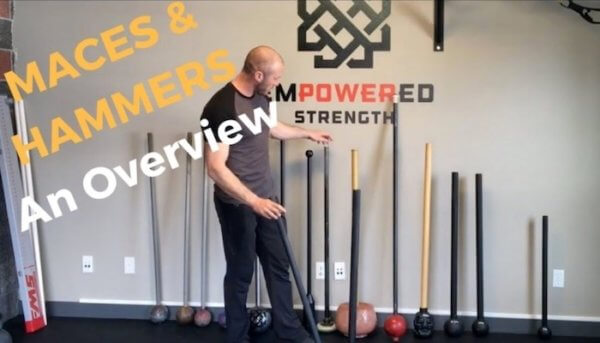Mace Gada Overview

This guest blog post was written by John Odden from Empowered Strength.
Gada Get the Goods
My journey with this unconventional training tool began on the Scottish Highland Games practice field while looking for an efficient warm-up for overhead shoulder range of motion and primer for throwing the Scottish hammer.
It would be “easy” to swing it behind me
I originally came across some obscure videos of Indian/Persian men swinging what looked like an oversized hammer, which sparked my interest to give it a try. So, I figured as a professional Highland games athlete and world record holder, it would be “easy” to swing it behind me as I had seen in those videos.
First attempt . . . WHACK! Right to the back of the hamstring.
Hmmm. Well, that didn’t go as planned.
The notion of incorporating this tool still intrigued me
I stopped there, put the mace down and went back to throwing my hammer in the traditional Scottish style. Yet, the notion of incorporating this tool still intrigued me. I loved the rotary pattern and overhead shoulder range of motion. A year or so later, I saw videos of some guys at Onnit swinging a shorter, black steel mace and became inspired again. This appeared to be a good starting point as the steel mace was much more rigid and shorter than the Scottish hammer. Thus, I purchased a 10lb mace from a friend and resumed where I left off from the hamstring incident.
Self-discovery became a necessity
It was instantly clear to me how less awkward the steel mace was to swing compared to my Scottish hammer. I caught on fairly quickly but knew something was missing and the weight of this mace felt “dead”. Somewhat comparable to a heavy steel pipe compared to a golf club. After mimicking the movements I had previously seen in the videos, I began to do more research. Unfortunately, there was very little published on the mace as far as “How To” at the time, so self-discovery became a necessity.
Mace Gada Overview by John Odden from Empowered Strength.
Gada Mace Mysticism
Although our main focus for this article is not the history of the mace/gada, but rather its usefulness as a training device, it’s still helpful to know where this tool came from. You can learn more here from my mentor and friend Paul Wolkowinski in his article called Gada Mace Mysticism. Without any further delay, let’s go ahead and get into it!
Choosing a Mace/Gada
Watch this video to see an overview of all of the maces (and hammers) that I own and utilize.
Break down the Elements
With more styles of training and brand options surfacing for maces, it’s important to consider your budget and intentions for implementing this tool into your training. The hype and creative use of the mace in social media can make things a bit confusing, so let’s break down the elements to consider.
Traditional gadas are generally made of bamboo, whereas most production maces are made of steel. My Scottish hammer is actually an electrical PVC conduit, a material that replaced rattan (very similar wood to bamboo, but comes from a type of palm tree) for practical reasons at many competitions and for training purposes.
Wood is also becoming more of a popular practical option. Rattan is an alternative material to consider as well, but it is not widely available to my knowledge. Rattan shatters where bamboo splinters when broken, so rattan could be a safer choice for heavy swing practice since it is more flexible.
Bamboo as a natural material has a flex to it which makes it feel more “alive” and whippy versus the rigidity of steel. The more flexible, the more “alive” and variable the mace feels.
Additionally, it’s reasonable to assume that you’d see more reactive/reflexive core contraction, shoulder stability and grip challenge with rattan and bamboo as opposed to steel. Adjustable maces can sometimes be loaded with water, sand, or shot to add another variable load perturbations (variable shaking). Onnit style steel is always a simple, cheap, durable workhorse option for those on a budget.
What to expect from different materials
| No Flex | Some Flex | More Flex | Most Flex |
| Max Durability | Great Durability | Less Durability | Least Durability |
| Steel | Hard Wood | Bamboo/Rattan | Electric Conduit |
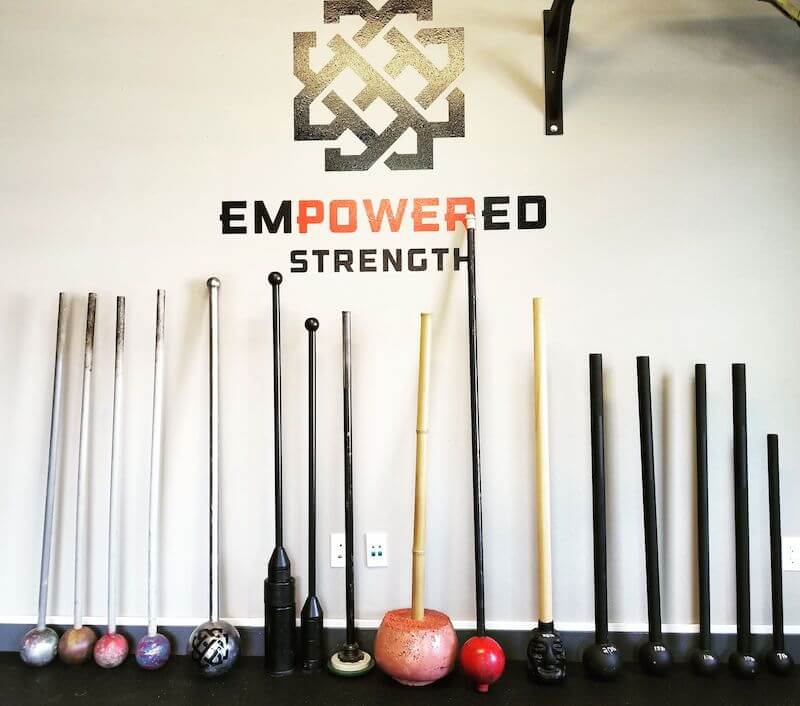
Mace Gada Overview by John Odden from Empowered Strength.
Length of implement
Handle length tends to vary among mace manufacturers. A longer lever creates more of floating, pendulum sensation in the backswing, resulting in the need for more stability, control and it will ultimately generate more torque.
A shorter mace may be more viable for those looking to perform offset drills or flow style movement patterns.
I personally prefer a longer lever when performing the traditional 10&2 and 360 drills. Mace length can typically vary between 40-60 inches. For your perspective, I am 6’2”, 220lbs with large hands.
What is torque you may ask?
Ultimately the key value of the mace is as a leverage tool, and torque is the force created during the rotation of this leverage while moving as fast as possible in the backswing. Torque by definition is a twisting or turning force that tends to cause rotation around an axis, which might be a center of mass or a fixed point.
Mace training is circular strength training that becomes an extension of the body as it rotation around the human structure, so torque is king once your technique is proficient.
A number of ways
The mace can be utilized in a number of ways outside of the traditional swings – hand to hand switches, single-arm drills, barbarian squats, and gravediggers to name a few beneficial movements outside of the traditional swing patterns.
Smooth Technique
Personally, I have found that 60 inches is the top end for a smooth swing in my own training based on my height (6’2”) and ability level (intermediate). Any longer and I also risk hitting the ground or my calves without perfect technique. Generally, I would rather load heavier or focus on powerful, smooth technique as opposed to pushing the boundaries further on the length.
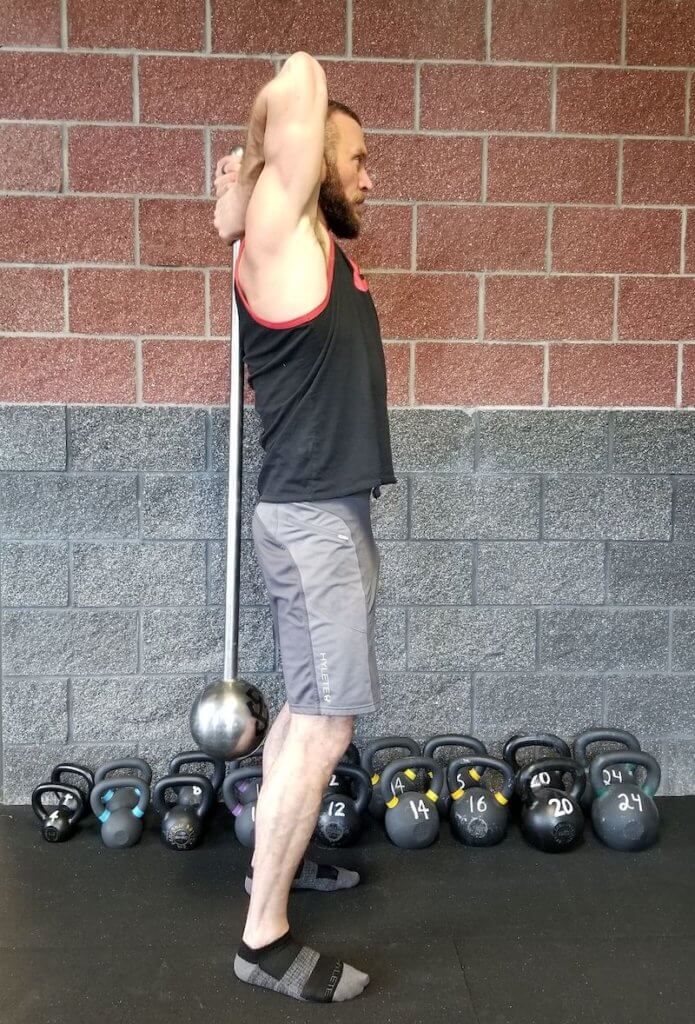
Here you can see the mace comes right behind my knee joint in the backswing to provide a great leverage point for my body type.
Handle Size and Feel
The thickness of the handle also varies between brands and styles of training, which will give each individual mace unique characteristics you may want to consider.
I prefer the feel of natural materials in my hand, but also really like several steel models that have a hardstyle kettlebell type of coating or toughened surface that works well.
My Favorite Mace Handles
My favorite mace handles are right around the size of a barbell diameter. The thinner the harder to control. This also adds to the feeling of “aliveness,” adding to the flow of mace movement as it orbits around the body while making the stabilizer muscles work harder. Too thick of a mace and you do not get enough feedback, so the implement feels sluggish when swung and the hands tend to fatigue first. Bamboo thickness varies and as a natural material, is not exactly symmetrical like steel.
Scottish Hammer
Technically the thinner the handle is the less weight in the handle. Likely an influence from my Highland Games experience, having less weight in the handle and more in the head feels good and also adds to the alive feel, as this is the same distribution and preference in the Scottish hammer. It also leads to much further throws!
Mace Gada Overview by John Odden from Empowered Strength.
Mass Produced Steel Maces
Many mass-produced steel maces like Onnit and Set for Set have a moderate to very thick handle with some aggressive knurling that is much like a barbell. This is a unique and valuable challenge on the grip, but I don’t feel it should be the primary focus with mace training. Plus, the thicker handles may detract from the overall value. Chalk or other grip aids are generally not necessary in most cases. Personally, I do use some chalk with heavier swings and high reps since I have extremely sweaty hands. I have also used a small amount of Highland Games “ tacky” to aid the grip without creating a crutch or too much of an aggressively locked-in feel.
Adjustable Maces
The ShoulderRok and Adex mace are both adjustable maces that have quite thin handles. The Adex is the smallest diameter on the market and does have a good feel, although it is a bit small for my large size hands. The ShoulderRok is literally a barbell knurl and diameter.
Other Brands
Most other adjustable models have a nice middle of the road sized handle that works well for most.
Highland Games Secret Sauce
The Scottish hammer has a nice ¾ inch diameter (barbell sized) end that has a relatively soft, natural feel in the hand, but requires some tacky (really sticky Highland Games secret sauce) to have a well-connected feel to it. It is very effective to learn to relax and tighten the grip when needed throughout any type of swing.
Bamboo and Wooden handles
The gada handles made of bamboo or wood are generally mid-sized handles (like a kettlebell). I have 36lb and 43lb gadas from William Cavalini that are quite different in handle size and whippiness. The 36lb gada has a very long, thin handle slightly less than ¾ in that feels very lively and reactive, whereas the 43lb is very thick (1½ in) and the end has a natural flair that acts like a very small pommel.
Thinner, natural handles have a higher risk of breaking, but definitely make for a nice whippy feeling overall and it’s much easier to relax the hands while swinging.
Paul Wolkowinski has a blog post and YouTube videos on how to make a proper homemade Gada – for safety reasons.
How to make a Clay Pot Gada Mace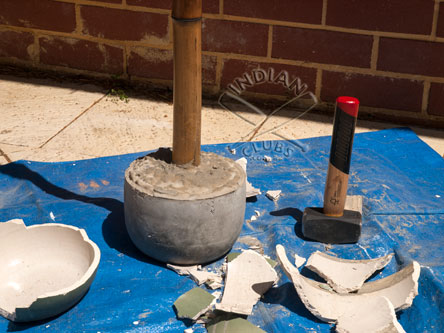
Mace/Gada Handles
Overall when it comes to handles, imagine again a steel pipe or wooden baseball bat compared to a golf driver. The difference is significant.
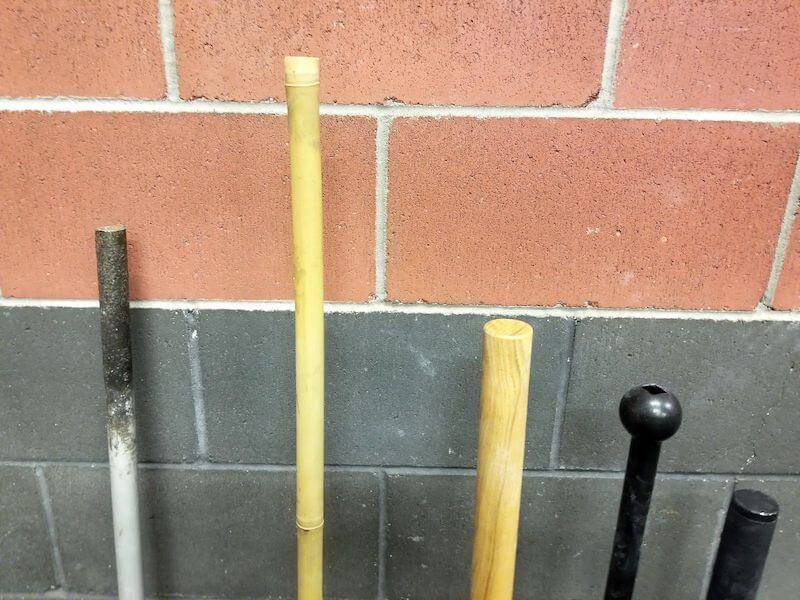
Handles from left to right, PVC pipe, bamboo, hardwood, ADEX (w/pommel), Onnit steel.
Pommel vs. No Pommel
The pommel can be a nice feature, especially for beginners to feel more confident with their swings. Many steel maces now have pommels. However, it can easily become a crutch and potentially harmful.
It’s Easy to Over-Tighten your Grip
Allowing a person to experience the flow of the mace swing along with the natural reactive need to tighten the grip as it comes around the head in the backswing is very important. It’s easy to over-tighten your grip, and slam your hands into the end of the mace, causing the wrist/hand to not flex, tighten/loosen, and articulate naturally throughout the movement. Once you become proficient with the mace, you will likely find that the pommel is not necessary and that you may prefer the bamboo feel.
Pommel or No Pommel
Paul Wolkowinski discusses what he calls the “skin grip” and why he feels the pommel is unnecessary and potentially harmful in this article along with the hand positions.
Adjustable Options
Several adjustably loadable mace options have recently hit the market.
Maces from Become Stronger, Evil Monkey and Ryan Pitts at Stronger Grip are fun options to grow into (many start at around 15 lbs unloaded and go up to 50+ lbs when fully loaded with metal shot), although I have not personally used Evil Monkey or Become Stronger maces, I can confidently say they are well made and worth considering.
Mace Gada Overview by John Odden from Empowered Strength.
I just recently received two maces from Stronger Grip and really appreciate the craftsmanship and true customization that Ryan does with his work. He is a true mace and metal “mad scientist” who loves to do creative work. The feel of the shot in the head of the mace really adds to the lively feel of the mace. The grip on these maces is exceptional as well.
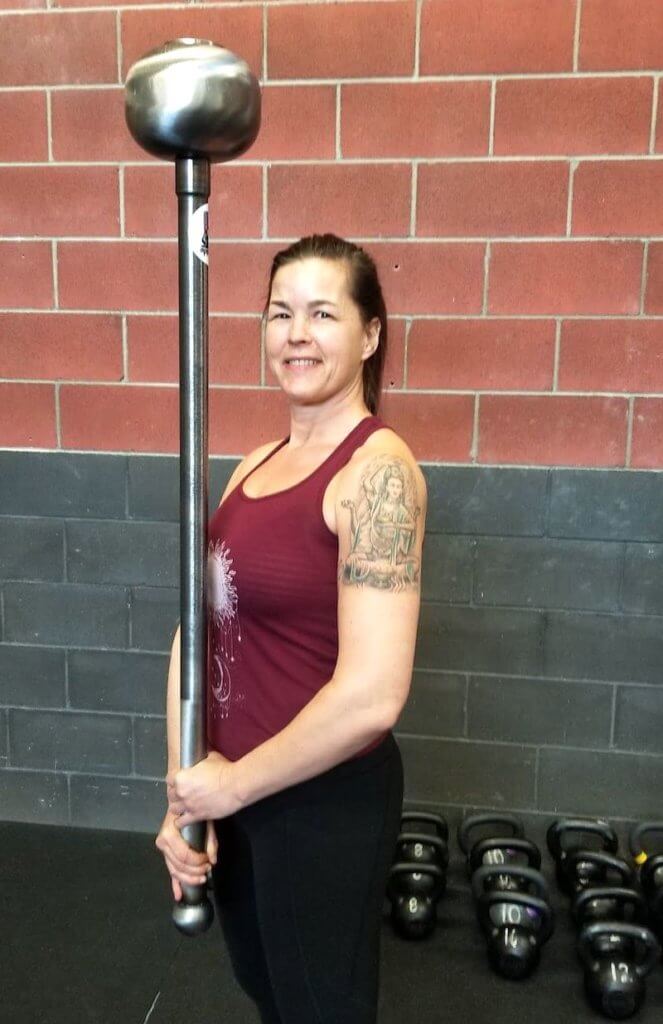
Stronger Grip Shot Loadable Mace
When partially filled with shot, sand, or water these all lend a nice challenge and give good feedback called perturbations (oscillations/shaking of the implement).
Adex Mace
As mentioned above, the Adex mace has a nice feel to it. Another benefit is that the donut-shaped weights that are added to the end will increase the length of the mace naturally, thereby increasing torque. You start with 7-10 lbs at around 40″ inches and can progress to the 50lb “Rhino” addition, which puts the total length up over 50″ inches.
ShoulderRok Mace
The ShoulderRok is another adjustable mace that is very well made. It can be tricky to get a totally locked down feeling with this device, and the threads are short when loaded with more than 1 plate. I found it is best used with rubber 2.5lb plates and less than 3 small 1-3lb plates, which keeps the weight at around 15lbs. When trying different loading options, it got pretty sketchy going up over 25lbs, since the width of the plates and ability to lock down the mace became more of an issue. What I do love about the ShoulderRok is the length is nearly perfect at 50 inches. is another tool that has a medium handle with a flared end that acts as a pommel. The grip material can be a bit intense since it is literally a mid-grade barbell knurl for the grip, so I don’t recommend the ShoulderRok if you want to swing over 20lbs or do multiple high rep sets of 360’s or 10-2’s.
Pro’s and Con’s of Adjustable Models
| Pro’s | Con’s |
|
|
Summary
Mace/gada material, length, and quality matter when considering your first or 20th mace (I know I have an addiction).
With more companies jumping on the mace bandwagon, you can be sure prices will be competitive and quality will be high, although you will generally get what you pay for as with most things in life.
Start light (7-10lb for ladies and 12-17.5lb for men) or consider a loadable option that will grow with you as you strengthen and your skill level progresses.
I would like to extend huge thanks to John Odden for contributing the Mace Gada Overview, a truly extensive and informative article.
